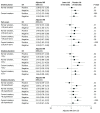Association of Cigarette Smoking and Alcohol Consumption With Subsequent Mortality Among Black Breast Cancer Survivors in New Jersey
- PMID: 36692882
- PMCID: PMC10148653
- DOI: 10.1001/jamanetworkopen.2022.52371
Association of Cigarette Smoking and Alcohol Consumption With Subsequent Mortality Among Black Breast Cancer Survivors in New Jersey
Abstract
Importance: There are limited data about how lifestyle factors are associated with breast cancer prognosis among Black or African American women because most of the evidence is based on studies of White breast cancer survivors.
Objective: To examine the association of prediagnostic cigarette smoking and alcohol consumption with all-cause mortality and breast cancer-specific mortality in a cohort of Black breast cancer survivors.
Design, setting, and participants: This population-based cohort study included 1926 Black or African American breast cancer survivors who received a diagnosis from June 6, 2005, to May 21, 2019, identified in 10 counties in New Jersey through rapid case ascertainment by the New Jersey State Cancer Registry. Statistical analysis was conducted from January 1, 2021, to August 1, 2022.
Exposures: Information on prediagnostic cigarette smoking, alcohol consumption, and additional covariates was collected during in-person interviews. The covariates examined included smoking status at the time of breast cancer diagnosis (currently smoking at the time of breast cancer diagnosis, formerly smoking, or never smoking), smoking duration (number of years smoking), smoking intensity (cigarettes smoked per day), number of pack-years of smoking, and regular alcohol consumption the year before diagnosis (categorized as nondrinkers, ≤3 drinks per week, or >3 drinks per week).
Main outcomes and measures: Primary outcomes included breast cancer-specific mortality and all-cause mortality.
Results: Among the 1926 women in the study, the mean (SD) age at breast cancer diagnosis was 54.4 (10.8) years. During 13 464 person-years of follow-up (median follow-up, 6.7 years [range, 0.5-16.0 years]), there were 337 deaths, of which 187 (55.5%) were breast cancer related. Compared with never smokers, current smokers at the time of breast cancer diagnosis had a 52% increased risk for all-cause mortality (hazard ratio [HR], 1.52; 95% CI, 1.15-2.02), which was most pronounced for those with 10 or more pack-years of smoking (HR, 1.84; 95% CI, 1.34-2.53). Similar findings were observed for breast cancer-specific mortality (current smokers vs never smokers: HR, 1.27; 95% CI, 0.87-1.85), although they were not statistically significant. There was no statistically significant association between alcohol consumption and all-cause mortality (>3 drinks per week vs nondrinkers: HR, 1.05; 95% CI, 0.73-1.51) or breast cancer-specific mortality (>3 drinks per week vs nondrinkers: HR, 1.06; 95% CI, 0.67-1.67).
Conclusions and relevance: This population-based cohort study of Black breast cancer survivors suggests that current smoking at the time of diagnosis was associated with an increased risk of all-cause mortality, particularly among women with greater pack-years of smoking.
Conflict of interest statement
Figures


Similar articles
-
Alcohol consumption and mortality after breast cancer diagnosis: The health and functioning in women study.Breast Dis. 2016 Jul 28;36(2-3):77-89. doi: 10.3233/BD-150202. Breast Dis. 2016. PMID: 27662274
-
Alcohol consumption, cigarette smoking, and familial breast cancer risk: findings from the Prospective Family Study Cohort (ProF-SC).Breast Cancer Res. 2019 Nov 28;21(1):128. doi: 10.1186/s13058-019-1213-1. Breast Cancer Res. 2019. PMID: 31779655 Free PMC article.
-
Prospective cohort of pre- and post-diagnosis alcohol consumption and cigarette smoking on survival outcomes: an Alberta Endometrial Cancer Cohort Study.Cancer Causes Control. 2024 Jan;35(1):121-132. doi: 10.1007/s10552-023-01777-w. Epub 2023 Aug 19. Cancer Causes Control. 2024. PMID: 37596424
-
Smoking, Alcohol, and Biliary Tract Cancer Risk: A Pooling Project of 26 Prospective Studies.J Natl Cancer Inst. 2019 Dec 1;111(12):1263-1278. doi: 10.1093/jnci/djz103. J Natl Cancer Inst. 2019. PMID: 31127946 Free PMC article. Review.
-
Association Between Daily Alcohol Intake and Risk of All-Cause Mortality: A Systematic Review and Meta-analyses.JAMA Netw Open. 2023 Mar 1;6(3):e236185. doi: 10.1001/jamanetworkopen.2023.6185. JAMA Netw Open. 2023. PMID: 37000449 Free PMC article.
Cited by
-
Neighborhood Disadvantage, African Genetic Ancestry, Cancer Subtype, and Mortality Among Breast Cancer Survivors.JAMA Netw Open. 2023 Aug 1;6(8):e2331295. doi: 10.1001/jamanetworkopen.2023.31295. JAMA Netw Open. 2023. PMID: 37647068 Free PMC article.
-
Associations between experiences of discrimination and quality of life in Black breast cancer survivors.Cancer. 2025 Apr 15;131(8):e35836. doi: 10.1002/cncr.35836. Cancer. 2025. PMID: 40193223 Free PMC article.
-
Racial Disparity in Anthracycline-induced Cardiotoxicity in Breast Cancer Patients.Biomedicines. 2023 Aug 17;11(8):2286. doi: 10.3390/biomedicines11082286. Biomedicines. 2023. PMID: 37626782 Free PMC article. Review.
-
Impact of Lifestyle Modifications on Cancer Mortality: A Systematic Review and Meta-Analysis.Medicina (Kaunas). 2025 Feb 10;61(2):307. doi: 10.3390/medicina61020307. Medicina (Kaunas). 2025. PMID: 40005424 Free PMC article.
-
A Comprehensive Review of Theaflavins: Physiological Activities, Synthesis Techniques, and Future Challenges.Food Sci Nutr. 2025 Aug 6;13(8):e70762. doi: 10.1002/fsn3.70762. eCollection 2025 Aug. Food Sci Nutr. 2025. PMID: 40772015 Free PMC article. Review.
References
Publication types
MeSH terms
Grants and funding
LinkOut - more resources
Full Text Sources
Medical

